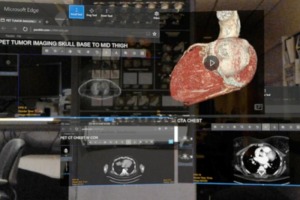Applications for virtual and augmented reality in medical imaging
by
Lisa Chamoff, Contributing Reporter | July 05, 2017

Virtual and augmented reality are not just for video games, with the potential to have a real impact on radiology.
During a recent webinar from the Society for Imaging Informatics in Medicine, physicians from the University of Maryland discussed the differences between augmented and virtual reality and their applications in diagnostic imaging and in image-guided intervention.
Dr. Alaa Beydoun, a resident at the University of Maryland Medical Center, explained that virtual reality replaces your environment while augmented reality supplements it. There is also a continuum, with various points in between, including what is called augmented virtuality.
The discussion centered on Google Glass and the Microsoft HoloLens, both wearable devices. At University of Maryland Medical Center, residents used Google Glass as a wireless monitor for ultrasound-guided procedures. They also used the Microsoft HoloLens as a 3-D viewer for DICOM data and in-vivo navigation for CT-guided intervention.
During ultrasound-guided biopsies, the physician can only look at their hand or at the ultrasound monitor
“With AR displays, we can bring that imaging within the operator’s field of view,” said Dr. Vikash Gupta, also a resident at the University of Maryland Medical Center.
The technology can be used to supplement traditional displays, providing an unlimited number of monitors or a completely virtual workstation, with customized settings for hanging protocols and how multiple studies are presented.
“This allows for a small physical footprint and mobility, changing where and how we practice radiology,” Gupta said.
The technology can also lead to a novel way to view 3-D reconstruction.
“Imagine – instead of scrolling through a 3-D set on screen you can create a holographic reconstruction that you can dynamically manipulate,” Gupta said. “You can walk around it, you can zoom and pan, you can look inside the virtual patient.”
Using what is referred to as augmented virtuality, the technology can also be used as a surgery emulator to train physicians.
“We can better prepare our trainees before they start in physical simulation settings for a fraction of that cost,” Gupta said.
Limitations on this technology include the fact that Google Glass is monocular, only displaying 2-D images to the right eye, and has a very low resolution, too low for diagnostic purposes. Neither device has been vetted for diagnostic purposes, Beydoun said. Google Glass also has no gesture control, while the MicroSoft HoloLens has object selection dependent on head position and limited gesture control. Neither can render the color black.
The device may also place a barrier between providers and patients.
“This is not exactly the best way to build rapport with your patients,” Beydoun said.
Future developments that could help advance the technology for use in health care include eye tracking, higher-resolution displays, larger fields of view and the ability to display images and holograms at multiple focal points, giving them a more natural appearance.
The consumer market is expanding, and new developments are expected that could augment the use of the devices in health care.
“As technology improves, AR and VR technology will probably be driven by the consumer devices,” Beydoun said.
|
|
|
You Must Be Logged In To Post A Comment
|
